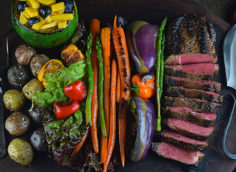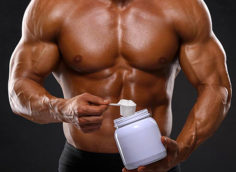As a T-mag reader, you're undoubtedly inundated with information on how to eat to improve your physique and/or sports performance. The brainiac duo of Drs. Berardi and Lowery have given you enough nutrition information to tie-up every single one of your cerebral neurons for months on end. It's all well and good, but for the purposes of this article, I'm going to spare you nutrition intricacies like the latest information on Glut-4 transporter translocation and just give you the Cliff's Notes–or Clay's Notes–on how to piece together meals and eating plans that'll help you achieve your physique and/or strength goals.
I'll provide some info on each of the macronutrients along with a tidy guide on how to determine how much protein, carbs, or fat you're getting in each meal.
 |
Protein
It's pretty well accepted that a protein intake of about 1.5 grams per pound of bodyweight is sufficient to support muscle protein synthesis. (For the record, you could bump that up to 2 grams per pound if that makes you feel better.) Although you could certainly opt for eating seven to ten smaller meals, most people find that six meals per day is a much more feasible number. For sake of simplicity, let's say that you weigh 200 lbs. This would have you eating 300 grams of protein per day. Divide that across six meals and you've got 50 grams per meal. Easy enough, huh (or eh if you live north of the US/Canada border)?
So, what, exactly, can you eat to give you 50 grams of protein? Funny you should ask. Below is a list of food choices that have approximately 50 grams of muscle-building protein. These should be considered your "staple" protein sources.
50 grams of Protein:
Chicken Breast: 6 ounces (170 grams) - baked or broiled
8 ounces (225 grams) - raw (before cooking)
Lean (95%) Beef: 7 ounces (200 grams) - cooked well
8 ounces (225 grams) - raw
Fish:8 ounces (225 grams) - baked or broiled
10 ounces (280 grams) - raw
Turkey Breast:6 ounces (170 grams) - roasted
7 ounces (200 grams) - raw
Egg Whites:2 cups - raw
Cottage Cheese:15 ounces (425 grams) - also contains about 20 grams of carbs
So, simply plop down one of the above portions (conveniently provided in ounces and grams) on your plate and you've satisfied your protein requirements for that meal. Of course, you could also use a powdered protein supplement. Since most types (Low-Carb Grow! included), contain about 20 grams of protein per scoop, 2 1/2 scoops will generally provide you with your 50-gram dose of protein. Refer to the product label for the exact serving size.
Carbohydrates
Knowing exactly how many grams of carbs one should consume is a bit more complicated and variable than protein intake. On one hand, consume too many carbs and you have a lipogenic (fat-forming) effect. On the other hand, eat too few carbs and you'll end up weak, flat, pumpless, and with little to no vascularity. Additionally, chronically consuming inadequate carbs will keep you from growing–and that's if you're lucky. Quite likely you'll end up shrinking.
With that being said, let me give you some guidelines for carb intake. I'll be the first to admit that these guidelines aren't based on some extravagant study done at a top university. Instead, they're based on my personal experiences gained from following them myself and helping others for over a dozen years.
So, if gaining mass is your primary goal, shoot for two to two and a half grams per pound of body weight. Thus, our hypothetical 200-pound male would consume about 400 to 500 grams of carbs per day. For purposes of slowly leaning up while maintaining or slowly gaining muscle mass, one to one and a half grams per pound of bodyweight should hit the nail on the head. Again, that's 200 to 300 grams for those of you who didn't major in math. Lastly, if getting super-shredded quickly is at the top of your to-do list, our 200 pound man should shoot for 100 grams of carbs per day, or about 1/2 gram of carbs per pound of bodyweight.
Another point worth mentioning regarding carb intake is timing. Both in-the-trenches experience and university studies agree that the vast majority of ones' daily carb intake should be consumed post-workout. Essentially, the nutrients consumed in the few hours after your weight-training dictate how well (and/or to what extent) one recuperates.
However, as Dr. Lowery has pointed out, we tend to metabolize carbohydrates better in the first part of the day as opposed to the latter part. This is fine and dandy if you train in the A.M. If you can't train until the evening, I'd still consume workout drink(s) during your workout and at least one carb-containing meal post-workout. Unless you have a really pansy-ass workout, I assure you that your starving muscles will "soak" those carbs right up. (For the record, I split the difference by training about noon or 1 PM, as I'm far from being a morning person. You'll see how I adjust my meals accordingly near the end of this article.)
As with protein, below I've provided you with staple carb sources and portion sizes that yield 50 grams of carbs. (If you're still thirsty for more information on how to fine-tune your carb intake, refer to "The Carbohydrate Roundtable" parts 1 and 2.) Feel free to mix and match these carb sources. For example, you'd probably want to have (for both flavor and physiological reasons) a mixture of rice and beans as opposed to one or the other. Try 4 1/4 ounces (120 grams) of cooked rice and 4 1/2 ounces (135 grams) of cooked beans to satisfy your requirement for 50 grams of carbs.
50g of Carbs:
Potatoes (White)8 ounces (225 grams) - baked
11 ounces (310 grams) - raw
Sweet Potatoes8 ounces (225 grams) - baked
10 ounces (300 grams) - raw
Pasta2.5 ounces (70 grams) – uncooked
7 ounces (200 grams) – cooked in water
Oatmeal3 ounces (81 grams) – uncooked
18.5 ounces (520 grams) – cooked in water
BreadUsually about 4 slices
Beans 12 ounces (340 grams) - cooked
Rice 2 1/2 ounces (65 grams) - uncooked
7 ounces (200 grams) - cooked
Fruit
A serving or piece of fruit typically contains between 20 and 25 grams of carbs. Because of the potential lipogenic effect of excess fructose (fruit sugar), I wouldn't advise consuming 50 grams worth of carbs from fruit in one sitting. For these reasons, I'm going to list carb servings from fruit in portions containing 20 to 25 grams of carbs.
Again, if you use your noggin' a little, you'll realize that you could have a piece of fruit and one of the starchy carb portions above to satisfy a carb requirement of 70 – 75 grams per meal. If you're paranoid of fructose, follow JB's advice and "just eat the damn fruit!"
20 to 25 Grams of Carbs from Fruit
Banana1 medium
Orange1 large
Apple1 medium to large
Pear1 medium
Kiwi 2 medium to large
Cantaloupe1/2 medium or 1/3 large
Strawberry11 ounces (300 grams)
Fat
Exactly how much fat one needs to consume is as debatable as whether or not Janet (Ms. Jackson if you're NASTY!) allowing Justin Timberlake to expose her tit to the world was in poor taste or just art. Consuming too much fat can, oddly enough, make you fat–more so if excess trans and/or saturated fat is consumed, or if high insulin levels are present. Too little fat will wreak havoc on ones' Testosterone levels, unless, of course, you "supplement" with Testosterone. Even in a "very anabolic" athlete, adequate dietary fat will facilitate muscle growth in a variety of ways.
It is, however, fairly well accepted that as ones' carbohydrate intake decreases, dietary fat can (and usually should) be increased a bit. This is especially true if you adhere to the Massive Eating guidelines laid out by the king of carb and fat separation himself, Dr. John M. Berardi. (He claims the M. is for Mack-Daddy, but I suspect otherwise.) Separating carbs and fats seems to allow you to "sneak in" more amounts of each throughout the day without gaining unsightly adipose tissue.
In my opinion, the only thing that's fairly definitive about fat intake is that it's beneficial to consume between six and nine grams of fish oil per day. (Opt for a product that has ample – 30% or more – DHA and EPA.) Otherwise, try to simply mix your fat sources such that you're consuming roughly 1/3 monounsaturated, 1/3 polyunsaturated, and 1/3 saturated. (For more information on fine-tuning your dietary fat intake, refer to the "Fat Roundtable" series of articles.)
As for guidelines on how much fat to consume, I feel that about 0.5 gram per pound of lean bodyweight is a good starting point. Below is a list of food servings that contain 15 grams each. If you separate your fat and carbs as I (concurring with JB and Lonnie Lowery) recommend, you'll probably need to double these servings to get your daily intake within your protein plus fat meals.
15 grams of Fat:
Oil1 tablespoon
Olives5 ounces (140 grams) of ripe (black) canned
3.5 ounces (100 grams) of green canned
Nuts1 ounce (28 grams)
Eggs3 whole eggs (also contains 15 grams of protein)
Avocado3 1/2 ounces (100 grams) – all varieties except Florida
5 1/2 ounces (150 grams) – Florida variety
Salmon5 ounces (150 grams) – raw (also contains 30 grams of protein)
4 ounces (120 grams) – cooked (also contains 30 grams of protein)
Fish Oil 15 1-gram capsules*
*Ideally you wouldn't consume this much fish oil with one meal, though.
Vegetables
I consider most vegetables to be "Free Foods." No, that doesn't mean they don't cost anything; it means that I consider them free of substantial caloric value. You could, and should, consume some veggies with every meal with the exception of your workout and/or post-workout shakes. Personally, I also don't like to consume them immediately prior to a workout as they contribute to a feeling of fullness–normally a good thing but not prior to a workout. Here's a partial list of veggies that can be considered free:
Free Veggies:
Lettuce, spinach, broccoli, cauliflower, yellow squash (not butternut), celery, beets, mushrooms, onions, brussels sprouts, eggplant, radishes, green beans, bell peppers, asparagus
Carrots and tomatoes can be considered free if you don't eat more than one (large) per meal. Eating more than that and the carbs can start to add up to a significant amount.
Conclusion
You've no doubt noticed that the above nutrition values represent just a small portion of the various types of foods that one could consume. However, don't overcomplicate things by losing sight of the fact that these foods should form the backbone of every eating plan. In fact, you could achieve the highest level of performance possible without eating any foods that aren't on this list–excluding supplements. Most people that have a physique that you would really covet eat these foods day in and day out. The only thing that really varies is the amounts of each. If eating these foods day in and day out sounds boring, you now know why not too many people really have kick-ass bodies.
To further illustrate how the above foods can be portioned and pieced together to form a meal plan, I'll give you my current nutrition plan that I'm using in preparation for the 2004 USA Bodybuilding Championship on July 16 & 17. My current physique goal is to slowly add lean mass while maintaining my current body fat levels.
My Current Nutrition Plan – About 4,000 CaloriesPCFCal.
Snack1 scoop (27g) Whey Isolate200080
1 Tbsp Flax Oil0014125
Meal1 cup egg whites2500100
81g (1 cup) Oats13545310
1 scoop (30g) Protein (whey/casein blend)203.50.5100
2 Kiwi Fruit (or 280g strawberries)0250100
2 Fish Oil capsules00220
1 Lg. Sliced Tomato w/ Morton's Lite Salt05025
Pre-Workout Drink
1 scoop Whey Isolate200080
1 scoop (40g) Glucose Powder0400160
Workout Drink
1 scoop Whey Isolate200080
1 scoop (40g) Glucose Powder0400160
Post-Workout Drink
1 scoop Whey Isolate200080
1 scoop (40g) Glucose Powder (+ creatine)0400160
Post-Workout Meal
12 oz (339g) Fat Free (FF) Cottage Cheese39150240
113g (1/2 cup) FF plain Yogurt59060
1 Banana0250100
8 oz White Potatoes0500200
3 Fish Oil caps002 20
Meal8 oz Chicken Breast5007265
12 oz Sweet Potatoe0750300
Meal 8 oz Lean Beef (93% lean)50012300
1 cup Veggies010040
1 Tbsp Olive Oil0014125
3 Fish Oil caps00220
Meal10 ounces Chicken65010350
Large Spinach Leaf Salad w/ Veggies012050
2 tsp Olive Oil, 2 tsp Flax Oil0020180
Snack1 Low Carb Bar (usually Lean Body)15188200
For the record I'm performing 30 minutes of treadmill walking (upon wakening) two to three times per week and weight-training five days per week. I currently weigh about 230 pounds with about 8% body fat. I'm 5'10"; have brown hair, blue eyes, and love long walks on the beach with a beautiful woman by my side. But I digress...




